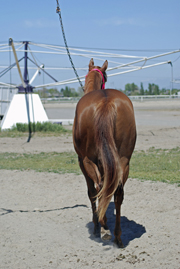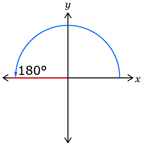Lesson 2
1. Lesson 2
1.8. Explore 4
Module 4: Foundations of Trigonometry

iStockphoto/Thinkstock
To this point in the lesson you have only been dealing with coterminal angles—angles where the terminal arms coincide. In Try This 3 you will explore angles formed by incomplete revolutions. You will explore how the distance a horse moves in a circle relates to the radian measure of the angle the horse travels.
Try This 3
In Try This 2 you looked at a horse walker with a radius of 6 m. The horses took 12 s to walk 1 revolution. You found the distance of 1 revolution to be


- What distance, and through what central angle, will the white horse travel after each specified amount of time that is less than 12 s? Complete a table similar to the one shown. The first column has been completed for you.
6 s 3 s 4 s Fraction of 1 Revolution of a revolutionDistance Travelled by White Horse to the Nearest Tenth of a Metre, or Arc Length
of a revolutionDistance Travelled by White Horse to the Nearest Tenth of a Metre, or Arc Lengthcircumference × amount of a revolution
 Diagram of Rotational Angle in Standard Position
Diagram of Rotational Angle in Standard Position Angle of Rotation in Degrees
Angle of Rotation in Degrees360° ×  = 180°Angle of Rotation in Radians
= 180°Angle of Rotation in Radians2π ×  = π
= π -
Explain how you determined the distance travelled by the horse.
- Explain how you determined the angle of rotation.
![]() Save your responses in your course folder.
Save your responses in your course folder.
Share 2
Discuss your responses to Try This 3 and the following questions with a classmate.
- How do your strategies compare for finding the distance travelled and the angle of rotation? What are the similarities and differences between your strategies and your partner’s strategies?
- What is the relationship between the distance around a circle (arc length) and the radian measure of the angle?
![]() If required, save a record of your discussion in your course folder.
If required, save a record of your discussion in your course folder.